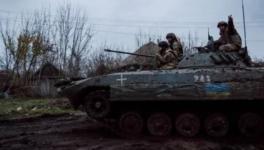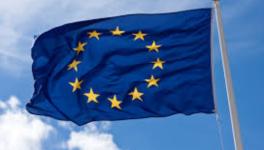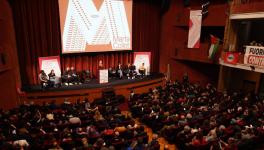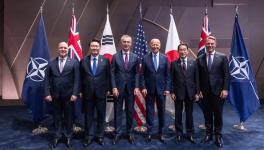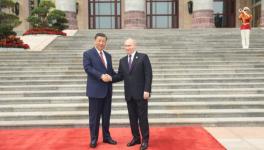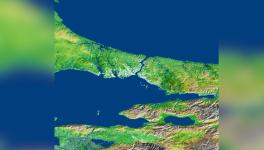Europe: Tanks Don’t Fill Lunchboxes
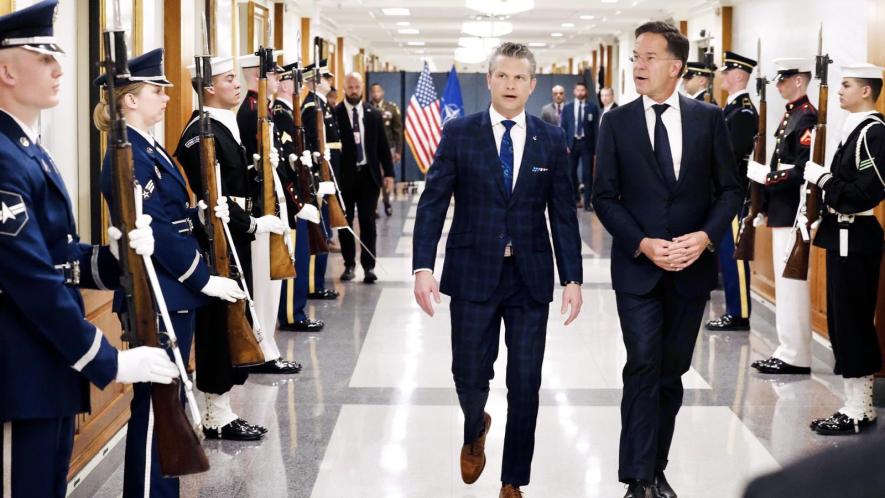
US Secretary of Defence Pete Hegseth with NATO Secretary General Mark Rutte. Photo: Mark Rutte / X
“The rearmament of Europe is not meant to replace NATO but to strengthen and diversify it. It will allow the US to focus on the Pacific and East Asia while Europe concentrates on defending NATO’s eastern flank,” says Belgian defense minister, Theo Francken, who is also vice-chair of NATO’s Parliamentary Assembly. Francken’s words reflect what is currently being thought in NATO circles.
According to Washington, the US is currently “overstretched” in the Indo-Pacific, a region encompassing the western Pacific and Indian Ocean. Here, the US is working to militarily encircle China. It already has bases in Japan, South Korea, and the Philippines, patrols the South China Sea, has partnerships like AUKUS (with Australia) and QUAD (with India), and an unwavering focus on Taiwan. But these military initiatives demand colossal resources: money, personnel, and logistics.
As China continues to grow, Washington gets entangled in multiple crises: Ukraine, the Middle East, and the Indo-Pacific. At the same time, domestic tensions in the US are rising. The military-industrial complex struggles to keep pace: ammunition stockpiles dwindle, shipbuilding lags, and maintaining readiness across all fronts becomes increasingly difficult. The once-unassailable American empire now grapples with the limits of its reach.
Thus, Washington declares: Countering Russia’s militarization is Europe’s job; we’ll focus on China. Europe may occasionally send a frigate to Southeast Asia, but that’s not its core task.
The consequence? Europe must dismantle its social security systems, privatize public services, and slash pensions to meet NATO’s insane new demands. All so the US can focus on its main adversary: China.
The failure of Europe’s strategy
As I argued in my book Mutiny (2023), the war in Ukraine has always had a “Janus face” – a duality. On one side, there’s Russia’s violation of Ukraine’s territorial integrity, a breach of international law. On the other, it’s a proxy war between the US and Russia, fought on the backs of Ukrainians, where tens of thousands of young people are sacrificed as cannon fodder for a geopolitical conflict.
Washington now openly admits this: It was a proxy war fueled and directed by the US But Trump now claims it was the wrong proxy war. He argues Russia isn’t the true adversary; instead, all efforts should prepare for the coming war against China.
With a predatory “peace deal,” Trump wants Europe to bear the costs of the war while the US secures control over Ukraine’s mineral and resource extraction. Trump aims to treat Ukraine like a colony, much as the US has treated many Global South nations. This reveals the war’s true nature: it’s not about values, but about geostrategic interests, as well as control of resources and fertile land.
Europe’s failure to pursue serious diplomatic initiatives for a ceasefire over the past three years is now backfiring. According to European Commission President Ursula von der Leyen, Putin must “lose this war.” Former Estonian Prime Minister (now EU Foreign Minister) Kaja Kallas declared peace “not a goal,” insisting the “solution must be military.” From the start, the EU refused to consider any resolution beyond escalating war. In Europe’s narrative, the words “peace” and “negotiations” became taboo.
At no point did European leaders demonstrate statesmanship through diplomacy or mediation. Instead, initiatives like Turkey’s were undermined by London and Paris. “We had three years to pursue peace, and not a single European leader took action!” says international relations professor Tom Sauer and try to prove him wrong. “Our strategy was to send weapons, money, and say, ‘Figure it out.’ We prolonged this war, to Ukraine’s detriment as Russia has been winning for the past two years.”[1]
Today, this strategy has visibly failed. Now, Trump unilaterally negotiates directly with Russia. Yet instead of learning from this disaster, parts of Europe’s establishment cling to the failed strategy, determined to prolong the war at any cost.
Contradictions abound. The same people who yesterday claimed victory over Moscow was imminent now warn that Moscow could “reach Brussels’ Grand Place tomorrow” unless Europe rapidly rearms. Both claims cannot be true. It’s clear their goal is to sell massive rearmament plans.
When German militarism gazes East
When German militarism gazes eastward, Europe picks up the pieces. This summarizes the two World Wars of the 20th century. In WWI (1914–1918), German youth were mobilized against “Russian despotism.” In WWII (1939–1945), sons of German workers were sent to the front to suppress the “Bolshevik threat.” The slogans changed, but the goal of eastward expansion remained.
Many who grew up in the 20th century learned that the combination of Germany, chauvinism, and militarism is a bad idea. The Ruhr Valley’s arms manufacturers fueled two of history’s most devastating wars. Post-WWII, Europe agreed: never again German militarism.
Suddenly, the world feels like a bad B-movie. Here it is again: Germany must rapidly reassert itself. Germany must embrace its “historic role.” Germany must militarize. We must “do whatever it takes” to counter the “Russian threat.” These words echo again in the Bundestag. It’s a déjà vu.
On March 18, 2025, the German parliament approved constitutional amendments enabling the largest rearmament program since WWII. It’s not that Germany doesn’t have an army today. To the contrary, Germany already ranks fourth globally in defense spending, up from the seventh place. Now, it’s turbocharging its “war readiness” to get kriegstüchtig.
German rearmament is now debt-financed – a radical shift. Until recently, Berlin blocked any proposal increasing debt. It still does for for social or green initiatives. Not so for public spending on the military.
Meanwhile and on top of German additional spending, the European Commission launched a massive militarization package, partly funded by debt and loans, partly by pillaging cohesion, climate, and development funds.
Originally named “ReArm,” the European Commission’s rearmament plan is now rebranded “Readiness 2030.” We must be ready in five years! To achieve this, Europe will spend €800 billion. All so the US can complete its military encirclement of China. Is the EU’s rearmament plan anything but a bow to Trump?
The military arm of an imperial Europe
While Europe’s official rhetoric speaks of peace and security, its policies tell another story. European Commission’s President Ursula Von der Leyen leaves no doubt: The EU must not only develop the means to defend its global interests but also to be ready to deploy them. In other words, Europe wants to be a geopolitical player in the power struggle with China and the US.
Yet no EU state is really willing to surrender its national army. Instead, a new layer is added: joint “battle groups” and military structures. Democratic oversight is lacking. National militaries have some accountability, but EU-level control is vague. The European Parliament lacks equivalent power or transparency, risking troop deployments without public awareness.
In February 2024, the EU decided to send warships to the Middle East – not to pressure Israel to stop its bombing and illegal annexation, as urged by the International Court of Justice,. No frigate has left its harbor for that. They did, however, to protect “free passage” in the Red Sea and Gulf of Aden, crucial trade routes. With other words, military ships protect European interests, not people.
Germany continues arming Israel; France arms Cameroon and Indonesia. European companies sell weapons to India, Pakistan, and Nigeria despite wars and oppression. In the Sahel, EU military missions over two decades have brought instability, not stability. The EU cares not for human rights but resources, trade routes, and spheres of influence.
The claim that Europe must rearm against Russia is full of holes. Europe already has four times as many warships, three times as many tanks and artillery, and twice as many fighter jets as Russia. Russia doesn’t want war with NATO – and even if it did, rebuilding its army after the war in Ukraine would take years. Brussels knows this full well.
EU rearmament isn’t just about freeing the US to focus on the Indo-Pacific; it’s about building a European military layer for interventions beyond defense. Some dream of a strong military arm for a new imperial Europe.
Where is Europe heading?
Sky-rocketing energy prices, technologically lagging behind China and the US, and a lack of industrial vision have plunged Germany – Europe’s economic engine – into recession. The US imposes 25% tariffs on European steel, aluminum, and cars, with Trump threatening more. This could cripple Germany’s car industry.
While Germany’s elite long remained loyal to Washington, Frankfurt’s financial circles increasingly advocate European sovereignty – independent from the US
This push for autonomy echoes in the EU’s new Defense White Paper. Europe must stand on its own. Today, 78% of defense purchases come from outside the EU, mostly the US The White Paper aims to reverse this: By 2035, 60% of equipment must be European-made.
This goal seems unrealistic. Europe’s arms industry is fragmented, with German, French, Italian, and British firms competing for billions. While Germany funnels money to Rheinmetall, Franco-Italian and Anglo-French alliances jostle for advantage.
There’s no unified command. The Kiel Institute for the World Economy (KfW) calls for 300,000 more European soldiers – but they’d serve 29 national armies. Recruitment and training remain hurdles.
True independence from the US is distant. Pro-US Trans-Atlanticists have long dominated the EU. Post-Brexit, the Baltics and Poland – built on anti-communism, Russophobia, and neoliberalism – have taken up London’s role. The appointment of Lithuania’s ex-PM Andrius Kubilius as an EU key figure makes this clear: “Expect no competition between me and NATO.”
The Baltics demand Europe abandon “strategic autonomy” and accept subordination to NATO. But why should all EU states align their foreign policies with Baltic and Polish priorities when facing other challenges? Le Monde Diplomatique asks: “The Iberian Peninsula fears climate change more than Russian invasion; France relies on nuclear deterrence; Germany benefits from East-West balance; Greece worries about Istanbul, not Moscow; Italy eyes the Mediterranean; Denmark is preoccupied with Trump.”[2]
Yet in March 2025, EU leaders reaffirmed loyalty to NATO. Ahead of June’s critical NATO summit in The Hague, Europe’s leaders meekly comply with Trump and NATO Secretary-General Mark Rutte. “Strategic autonomy” remains distant – and if achieved, it would only serve European imperialism.
Under capitalism, “security” is trapped in a web of resource control, trade routes, geostrategy, and global redivision. We need a new definition: security as access to water, food, healthcare, protection from pandemics and climate chaos. Achieving this requires a different Europe – one of peace, solidarity, democracy, and socialism.
Social security is the new cannon fodder
“The UN’s 0.7% aid target is ignored. Climate goals are missed. These are greater threats than Russia. You can talk to Russia, but not to the climate,” argues Professor Tom Sauer.[3]
He has a point. Social and ecological targets are trampled for decades, but military spending is treated as sacred. When Trump and Rutte demand 2% of GDP for NATO, no one questions it – except Sauer: “Why 2%? That’s a political fetish, not law.”[4]
Belgium doubled military spending from €3.9 billion (2017) to €7.4 billion (2024). To hit the 2% fetish, the 2025 Easter Agreement raises it to €12.8 billion annually – €5 billion more yearly, stolen from pensions and social security.
Before even achieving this, whispers of a new NATO demand emerge: 5% of GDP for defense, 3.5% for “hard defense.” For Belgium, that’s €22.3 billion yearly – €15 billion more than 2024. Lunacy. That’s our pensions. Our public services. Our healthcare.
When Defense Minister Theo Francken praised the US model this year, some thought it a bad joke. “We laughed at US poverty, addiction, lack of safety nets, $1,000 dentist bills,” Francken told De Tijd. “We didn’t want to live there because they spent on ‘hard security.’ It’s nicer to fund pensions, unemployment, a ‘Cuban model’ where €13 buys a large bag of medications at the pharmacy. But who was right?”[5]
Who’s right, the NATO Parliamentary Assembly’s vice-chairperson asks. Those pouring billions into a warmongering military-industrial complex while millions lack basic protections? Those wasting money on imperialist wars while six million Americans battle opioid addiction? Those charging $1,000 for dental care? Francken’s message is clear: The shift to a war economy will kill social security.
French journalist Rémi Godeau agrees: “Let’s be clear, the war economy means longer work hours and rationing the welfare state’s ‘excess.’”[6] Social security, housing, elderly care – all “excess.” Francken calls social security “too fat”, but he won’t spare a word for arms industry dividends, corruption, and billionaire hoarding.
What von der Leyen calls the “era of rearmament” means an era of social dismantling for Europe’s working class. More money for tanks means less for pensions; more for drones, less for childcare.
“The German government ordered, among others, 105 Leopard II tanks from Rheinmetall. One tank costs €27.8 million. A new primary school in my district costs €25 million. What’s good for Rheinmetall is bad for our children,” says Gesine Lötzsch of Die Linke. She’s right. These are political choices with consequences that will haunt us for decades. There’s no reason to accept them – it’s never too late to say no.
Breaking the Deadly Arms Race
In the narrative of Trump, Rutte, and Francken, we supposedly have too few weapons. That is grotesque. Military spending on Earth has been moving in only one direction for the past ten years: upward! Last year, 2.718 trillion dollars were spent globally on armaments, an increase of nearly ten percent compared to the previous year, according to calculations by the Stockholm International Peace Research Institute (SIPRI). That is the strongest increase since 1988. Military spending by European countries will rise to 693 billion dollars in 2024. This is an increase of 17 percent compared to 2023 and 83 percent compared to 2015. How can there be too few weapons?”
The world is slowly suffocating under a hallucinatory arms race. It always follows the same logic: if one country upgrades, others will follow. Anyone who pursues the logic of deterrence to its inevitable conclusion will end up advocating for the nuclear armament of Germany and Europe.
At worst, this spiral will culminate in a major war with many losers and few winners. History teaches us that this dangerous vortex can only be broken through mutual disarmament treaties. This requires sober diplomacy, but also a robust international anti-war movement applying pressure from below.
Arms production won’t save the economy
“What many forget when hearing these astronomical defense figures is that this tax money largely flows back into our economy.” So claims our Defense Minister, Theo Francken. The title of his X post leaves no room for doubt: “Defense is business!”
The advantage of Minister Francken is his ability to articulate NATO and arms industry talking points so clearly. The theory that increased militarization will boost the economy is an evergreen of the military-industrial complex. They proudly call it ‘military Keynesianism’: have governments massively subsidize the arms industry. Now that Europe’s auto sector is floundering and Germany faces its third consecutive year of recession, they want us to believe switching from cars to tanks is the solution.
This is nonsense, of course, because families don’t buy tanks. You don’t drive a tank to grandma’s house. Yet these tanks must be sold. To sustain this industry, they must be used – otherwise, the sector collapses. In other words, militarizing the economy creates permanent pressure for war. A war not meant to be won, but to be endless, because peace threatens profit margins.
The only way to sustain this, is through perpetual war. This is Washington’s model: 850 global military bases, endless interventions, and coups. The Korean War (1950), the Bay of Pigs invasion (1961), Vietnam, Grenada and Panama (1980s), the Gulf War (1991), Afghanistan and Iraq (21st century), the proxy war against Russia in Ukraine – the list goes on. Permanent war is the lifeblood of military Keynesianism.
Moreover, the new arms race is to be funded partly by debt. “Just like in the US,” say the warmongers. They omit that US debt is historically high, and inequality has never been worse. This is the cost of near-permanent war.
Tanks don’t fill lunchboxes. Higher military spending won’t raise living standards. Arms production offers no economic benefits. Building tanks, bombs, or missile systems contributes nothing to the broader economy. The myth of job creation is equally false: €1 invested in hospitals creates 2.5 times more jobs than €1 in weapons. In terms of employment efficiency, defense ranks 70th out of 100 sectors.
Even arms industry jobs aren’t secure – they depend on perpetual war. Francken’s claims are false. The billions funneled to arms manufacturers don’t ‘flow back’ to society. They flow to one group: the arms makers themselves. Profits for Rheinmetall, Dassault, BAE Systems, Leonardo, Thales, and Saab have reached astronomical levels.
“Returns have soared up to over 1,000% in three years. The sector averages 400–500%. It’s enormous, unprecedented,” says KBC Bank’s chief economist. Yes, Francken is right about one thing: defense is big business.
Peace builds care, war builds ruin
To further fuel the overheated push toward militarization, Belgian Prime Minister Bart De Wever eagerly revives a late Roman slogan – once meant to halt the decline of the Western Roman Empire through stricter military discipline and higher defense spending: “Si vis pacem, para bellum” (“If you want peace, prepare for war”). This was never a slogan of peace. It has always been a rallying cry for militarization and war. But militarization does not strengthen society. Mere decades after Rome embraced it, the empire collapsed irreversibly.
History teaches us: Wars and arms races are not stopped from above. Those in power halt militarization and war only when pressured from below. It is the people who pay the price – with their livelihoods, their futures, their children – who can make the difference. If the labor and peace movements join hands and unite, much becomes possible.
The left must not conform to the new military consensus. Instead, it must boldly challenge the West’s hypocrisy, its warlike conflicts of interest, and the destructive arms race.
“Wenn wir zum Krieg rüsten, werden wir Krieg haben” (“If we prepare for war, we will have war”), wrote German poet Bertolt Brecht in the lead-up to World War II. The bitter reality of the 20th century proves his point. The lesson is simple: Those who want peace must prepare for peace, not war.
When it comes to war, billions suddenly seem to materialize effortlessly. When it comes to people, they don’t. This is a world turned upside down. We don’t need NATO – we need peace. The arms race does not lead to security, but to greater inequality, more violence, and endless war.
Peace will not be achieved by surrendering to the dogma of militarization and today’s military fetishes. It requires building new power structures. Peace is not inevitable – it is the result of struggle. A struggle that embeds demands for social progress into a different logic, one daring to think beyond the constraints of capitalism. This system, where powerful monopolies impose profit-driven domination through conquest, war, and an economy of destruction, offers no future for humanity or the planet. “It’s barbarism or socialism,” declared Rosa Luxemburg. We choose the side of labor, peace, and socialism.
—–
[1] Humo, March 25, 2025
[2] Pierre Rimbert, Faire la guerre pour faire l’Europe. Le Monde Diplomatique, Dossier avril 2025, Le piège du grand réarmement.
[3] Humo, March 25, 2025
[4] Tom Sauer in Humo, March 25, 2025
[5] Defense Minister Theo Francken (N-VA): ‘Belgische boots on the ground in Oekraïne? Dat is de logica zelve’. De Tijd, Februari 15 , 2025.
[6] Rémi Godeau, L’Opinion, February 27, 2025
Courtesy: Peoples Dispatch
Get the latest reports & analysis with people's perspective on Protests, movements & deep analytical videos, discussions of the current affairs in your Telegram app. Subscribe to NewsClick's Telegram channel & get Real-Time updates on stories, as they get published on our website.









